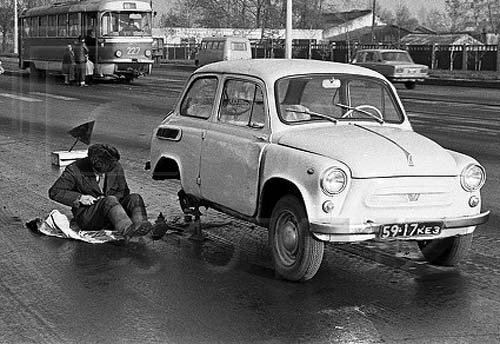Zaporozhets: Fix It Anywhere

The Zaphorozhets (aka “The Soviet Corvair”) didn’t offer much in terms of performance, comfort, safety, or style, but it was the first real attempt by the post-Stalin USSR to offer a car for ordinary citizens. The idea was that the heroes of Soviet labor would enjoy some of the bourgeois luxuries of their capitalist counterparts, and this would lead to increased worker productivity, or something. The proletariat wasn’t going to get ’57 Ford Mainlines, however; the reality of Soviet roads and repair facilities was such that their cars would need to be easy to repair under primitive conditions.
So, when ZAZ engineers ripped off the design of the Volkswagen air-cooled engine for their new car, they bent the cylinders up in a vee instead of using a boxer design. Why? So that the valves, which we must assume went out of adjustment even more quickly than the VW’s (i.e. every 200 miles instead of every 2,000), could be more accessible when working in a mud-floored shack in Turkmenistan. This philosophy was carried through for the entire car. When one of the rear brakes fails on a Leningrad street, why, you just stop right where you are and fix it with whatever rusty tools you find rattling around on the floorboards. Isn’t that the reason everyone loved the Model T so much? I say the humble Zaphorozhets needs more recognition as the perfect car for its time and place!

Murilee Martin is the pen name of Phil Greden, a writer who has lived in Minnesota, California, Georgia and (now) Colorado. He has toiled at copywriting, technical writing, junkmail writing, fiction writing and now automotive writing. He has owned many terrible vehicles and some good ones. He spends a great deal of time in self-service junkyards. These days, he writes for publications including Autoweek, Autoblog, Hagerty, The Truth About Cars and Capital One.
More by Murilee Martin
Latest Car Reviews
Read moreLatest Product Reviews
Read moreRecent Comments
- SCE to AUX Range only matters if you need more of it - just like towing capacity in trucks.I have a short-range EV and still manage to put 1000 miles/month on it, because the car is perfectly suited to my use case.There is no such thing as one-size-fits all with vehicles.
- Doug brockman There will be many many people living in apartments without dedicated charging facilities in future who will need personal vehicles to get to work and school and for whom mass transit will be an annoying inconvenience
- Jeff Self driving cars are not ready for prime time.
- Lichtronamo Watch as the non-us based automakers shift more production to Mexico in the future.
- 28-Cars-Later " Electrek recently dug around in Tesla’s online parts catalog and found that the windshield costs a whopping $1,900 to replace.To be fair, that’s around what a Mercedes S-Class or Rivian windshield costs, but the Tesla’s glass is unique because of its shape. It’s also worth noting that most insurance plans have glass replacement options that can make the repair a low- or zero-cost issue. "Now I understand why my insurance is so high despite no claims for years and about 7,500 annual miles between three cars.



































Comments
Join the conversation
Ahh, Russian cars. Owned two of them, a Lada 2106 sedan, which, in a moment of masochism I traded for a Niva to drive across Canada in the winter. Can't get into too much trouble at 90 kph. The roadside repair photo brings back many memories. The points in my 2106 would last exactly 2 oil changes. Got so I could change oil, filter and points in 20 minutes flat. Sometimes even set the timing afterwards. The models sold in Canada actually encouraged diy repairs, as they came with two (2) tool kits. The first was a large roll-up affair that contained the usual lug wrench as well as an engine crank, a set of 3 flat tire irons, and a manual air pump. The 2nd kit was in a small plastic case and contained points and spark plug files/gapping tools as well as remarkably crappy screw drivers and a pair of sand cast pliers. Despite quite a few Ladas being sold here in the late 70's and early 80's, virtually none still exist. Read somewhere that boat loads of used sedans were shipped back for sale in Russia in the 90's as the export version was considered to be better quality. Could be an urban myth.
I had Lada 2108 two door hatchback. No power steering, no power anything except of brakes. Well every other trip to Moscow I had to stop (actually car stopped on its own will) somewhere on the highway or freeway (sometimes in the middle) and fix something, most of time the carburetor, some time the fuel pump. I had some spare parts in the trunk. Like timing and accessory belts e.g. or fuel pump repair kit. Motor oil was of unknown local origin, I suspect it might be not actually the motor oil. But I did not see a point of spending much more for an imported real motor oil for such a car. The good thing is that it was the only Russian car I ever owned.